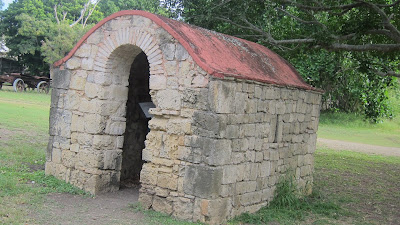LIVING QUARTERS
The greathouse was a planter's pride
and joy. It was usually built by slave laborers and craftsmen. (The
slaves' social hierarchy consisted of: craftsmen; household slaves;
field laborers.) Whim's greathouse was built about 1760 and rebuilt
several times. Its furniture is made of local mahogany, tibet and
saman. The oval shape came in 1793. Measuring 95ft x 35ft with 16
foot ceilings, it contains 3 large rooms (bedroom, dining room,
living room). The walls are 30 inches thick, built of cut brain
coral, limestone and rubble, and were bonded together by a mortar
containing molasses. The cellar, ringed by a dry moat, was used to
store food rations for the laborers.
Front of Greathouse
East End of Greathouse
Dining Room
Outbuildings near the greathouse housed
the cookhouse, domestic quarters, privy (for owners' use
only), and the village row house where plantation workers lived. A
caretaker's cottage was also nearby.
Exterior of Cookhouse
Interior of Cookhouse
Ovens in Cookhouse
Exterior of Privy
Privy Interior
Village Row House
Caretaker's Cottage
PRODUCTION STRUCTURES
The animal mill was the earliest mode
of crushing juice from cut sugar cane, using oxen, mules or horses.
The windmill was the West Indian
adaption of Dutch grinding mills. As with the animal mill, slaves
hand-fed the cane back and forth between three vertical rollers. Cane
juice drained down a sluice to the factory. The slaves who did this
job worked well into the night, long after the field laborers had
finished cutting the cane and loading it into carts for transport to
the mill.
The sugar factory, now in ruins at this
plantation, was an immense, two-story, T-shaped structure. It was
there where sugar, molasses and rum were produced and prepared for
shipment to markets in Europe and America.
Eventually, steam engines replaced animal and wind power, resulting in 15% more cane juice. They could handle 20 to 30 tons of cane in 12 hours.
Animal Mill (left); Windmill (far center); Steam Engine (near center); Ruins of Sugar Factory (right)
Windmill
Vertical Rollers that Pressed the Sugarcane
The chimney shown below is the third to be
built for this sugar factory, and was in place by 1908. In addition
to about 100 old sugar mills on St. Croix today, there are a number
of chimneys still visible on the island.
The watch house was located near the cane fields and sheltered watchmen who guarded the crop from fires and thieves, while keeping a lookout for runaway slaves. During the workday, little children stayed there while their mothers worked in the fields.
FINAL COMMENTS
Growing sugar was hard work. A planter
and his manager had to know how to plant a crop and bring it in; how
to make sugar, molasses and rum and get them to market; how to build;
how to motivate enslaved labor; and how to deal with island
merchants, ship captains and bankers. Work went on year-round, and
had to contend with drought, hurricanes, fluctuating market prices,
and the hazards of shipping. Considerable investment, much of it
borrowed at high rates, was needed for buildings and machinery, as
well as for land and slaves.
Slaves worked from dawn until dark,
with two hours off for a meal, six days a week. At crop time they
worked around the clock. Males and females, with children in tow,
labored together to plant, weed, or cut in season. Sharp cane leaves,
biting ants and spiders, and hot sun made the work miserable. Men
worked the mill and boiling house, tended stock, carted sugar to the
dock, served in the household, constructed buildings, and became
artisans. Women cooked and sewed, tended garden plots, and sold
surplus produce in the public market.
It was a life we can hardly even
imagine! The moral to remember: count your blessings!
Current Resident at Rest



















